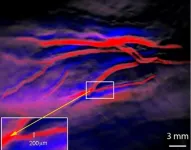(Press-News.org) Researchers at OU Health Stephenson Cancer Center at the University of Oklahoma Health Sciences have embarked on a revolutionary new research study that could improve the detection of a deadly disease — pancreatic cancer — and give patients a chance to live longer, healthier lives.
The research focuses on an innovative combination of imaging techniques: a newly created contrast agent that recognizes pancreatic cancer cells, paired with Multispectral Optoacoustic Tomography, or MSOT. Together, the approach can detect pancreatic cancer cells the width of an eyelash — approximately 10 times more magnitude than what is currently possible. The research is led by Lacey McNally, Ph.D., and Ajay Jain, M.D., who are professors of surgery at the OU College of Medicine. They received a $3 million grant from the National Cancer Institute of the National Institutes of Health for this project, which is believed to be among the first of its kind in the world.
“Pancreatic cancer is one of the hardest cancers to cure because it is difficult to detect cancer cells at the microscopic level,” Jain said. “Because there are usually no early symptoms of pancreatic cancer, it is typically not diagnosed until after it has spread, and outcomes are very poor — about a 9% overall chance of survival. Surgery and chemotherapy offer the patients the best chance, but for surgery to work, we have to remove all the cancer, and that is difficult to do.”
The new imaging approach aims to improve the detection of pancreatic cancer cells at the microscopic level, or about 200 microns, about as thin as an eyelash. Current imaging options like the CT scan only detect cancer when it grows larger, about a centimeter in size.
The promise of the new imaging approach is in the combined strength of its two elements. In the laboratory, McNally devised a contrast agent unique to pancreatic cancer cells. When the agent is delivered via an IV, it can differentiate pancreatic cancer cells from other cells because the environment of pancreatic cancer is acidic. When the contrast agent encounters that acidity, its dye essentially “turns on.”
The other component, the MSOT device, works in concert with the contrast agent. The MSOT delivers infrared light into the body, which stimulates the dye of the contrast agent. That stimulation creates sound waves, which the MSOT device picks up and converts into colors. The result is an image so detailed that it captures cancer cells that otherwise would evade detection.
“This is a hybrid approach that accomplishes what a CT cannot,” McNally said. “Pancreatic cancer often creates tentacles that spread out beyond the primary tumor. Currently, there is no way for the surgeon to know where they are. But if the surgery team can use this MSOT approach in the operating room, it can tell them in real time where the cancer has metastasized so they can remove it.”
That capability would be a game-changer for pancreatic cancer surgeons. Pancreatic cancer disproportionately affects people 60 and older, who face greater risks from a major operation than younger patients do and usually cannot withstand a second surgery.
“The first questions patients ask me are, ‘Will the surgery be worth it? What are the chances that you’ll get it all?’ This approach, at a very microscopic level, appears able to inform us whether we are getting all the cancer,” Jain said.
The new imaging technique could also help surgeons plan the surgical approach they want to take. If the MSOT device reveals, for example, that cancer has invaded the two critical blood vessels that hug the head of the pancreas, surgeons would conduct the procedure differently than if they didn’t know. If chemotherapy is given before surgery, the imaging could tell whether cancerous cells on the blood vessels are dead or if microscopic cancer is still present.
Ultimately, the new imaging approach could be used as a screening tool in patients who face a high risk of pancreatic cancer, such as those who have a family history or have a genetic predisposition. “Early detection of pancreatic cancer offers the best chance of a cure,” Jain said. “If we could detect the cancer at an early, microscopic stage, it could be curable.”
The grant's funding will allow McNally and Jain to continue testing the imaging technique. McNally is an international leader for her research expertise in using the MSOT device with contrast agents she has developed for various cancers. She is testing the imaging approach in several other clinical trials at OU Health Sciences, including a recently completed study in breast cancer. While MSOT technology is not new, it is novel in medicine, and funding agencies like the NIH are increasingly supporting studies in the field. McNally and Jain’s grant scored in the first percentile out of approximately 55,000 grants submitted last year to the National Cancer Institute, which points to the strength of the research.
“This type of research collaboration between a translational scientist and a surgeon is extremely unusual,” McNally said. “We have the opportunity to improve a surgical technique. The scientific and medical communities have made great strides in treating some types of cancer, but pancreatic cancer patients have the poorest survival. The outcome of this research could fundamentally change people’s lives.”
The University of Oklahoma and Georgia State University jointly own pending patent applications on contrast agents and using the MSOT device with contrast agents.
Research reported in this press release is supported by the National Cancer Institute, a component of the National Institutes of Health, under award number 1R01CA281098-01A1.
###
About the University of Oklahoma
Founded in 1890, the University of Oklahoma is a public research university located in Norman, Oklahoma. As the state’s flagship university, OU serves the educational, cultural, economic and health care needs of the state, region and nation. OU was named the state’s highest-ranking university in U.S. News & World Report’s most recent Best Colleges list. For more information about the university, visit www.ou.edu.
END
OU scientists tests revolutionary imaging technique for pancreatic cancer
2024-01-29
ELSE PRESS RELEASES FROM THIS DATE:
Rising sea levels could lead to more methane emitted from wetlands
2024-01-29
As sea levels rise due to global warming, ecosystems are being altered. One small silver lining, scientists believed, was that the tidal wetlands found in estuaries might produce less methane – a potent greenhouse gas – as the increasing influx of seawater makes these habitats less hospitable to methane-producing microbes.
However, research from biologists at Lawrence Berkeley National Laboratory (Berkeley Lab) and UC Berkeley indicates that these assumptions aren’t always true. After examining the microbial, chemical, and geological features of 11 wetland zones, the team found that a wetland region exposed ...
Study urges people to think twice before going on a diet
2024-01-29
A new qualitative study highlights the negative interpersonal and psychological consequences associated with “yo-yo dieting,” also known as weight cycling. The work underscores how toxic yo-yo dieting can be and how difficult it can be for people to break the cycle.
“Yo-yo dieting – unintentionally gaining weight and dieting to lose weight only to gain it back and restart the cycle – is a prevalent part of American culture, with fad diets and lose-weight-quick plans or drugs normalized as people pursue beauty ...
Astronomers spot 18 black holes gobbling up nearby stars
2024-01-29
Star-shredding black holes are everywhere in the sky if you just know how to look for them. That’s one message from a new study by MIT scientists, appearing today in the Astrophysical Journal.
The study’s authors are reporting the discovery of 18 new tidal disruption events (TDEs) — extreme instances when a nearby star is tidally drawn into a black hole and ripped to shreds. As the black hole feasts, it gives off an enormous burst of energy across the electromagnetic spectrum.
Astronomers have detected previous tidal disruption events by looking for characteristic bursts in the optical and X-ray bands. To date, these searches have ...
The DiAL-Health study will help determine how intermittent fasting and calorie counting can improve a person’s “healthspan”
2024-01-29
January is a time when many people are looking for new diet routines, and intermittent fasting is trending, as are traditional calorie cutting programs.
Research conducted with animal models suggests that intermittent fasting slows aging, and those animals live longer. Researchers at the Pennington Biomedical Research Center and the University of Alabama at Birmingham are conducting the DiAL-Health study to see if eating for 8 hours and fasting for 16 each day shows similar results in people. These researchers ...
From simulation to reality: Making social media a safer space for kids through AI
2024-01-29
Like it or not, social media has become the new mall for kids. It’s where they want to be, and it’s a place they can easily go—often with no guidance, no oversight, and no guardrails. And when the content gets ugly or confusing or weird, it can be tough for them to know what to do.
Dominic DiFranzo, an assistant professor of computer science and engineering in Lehigh University’s P.C. Rossin College of Engineering and Applied Science, has devoted his research to helping kids better navigate the perils of social media. He and his team have recently received two grants from the National Science Foundation to develop artificial intelligence tools ...
Shah studying fingerprinting technology for enhancing 5G/NextG O-RAN supply chain risk management
2024-01-29
Vijay Shah, Assistant Professor, Cybersecurity Engineering, received funding for the project: "Fingerprinting Technology for Enhancing 5G/NextG O-RAN Supply Chain Risk Management."
In this project, Shah is focusing on distinctive power signatures and electromagnetic emanations to fortify supply chain risk management of 5G/Next G networks.
This technology has the potential to create a robust framework for comprehensive validation and testing across the entire lifespan of deployed Open Radio Access Network (O-RAN) systems. This, in turn, could ...
From Baby Boomers to Gen Alpha – Is it time to stop talking about generations?
2024-01-29
'Millennials don't really want to work. They're far too focused on avocado toast and chai lattes!' Just one of the many clichés expressed by workers over the age of fifty. And those being criticized? Well, they often reply with a bored 'OK, Boomer' followed by an eye roll and some ironic remark about the excessively performance-driven worldview of those born between the mid 1950s and the mid 1960s. Work, it seems, just isn't as important to the young as it is to older generations. But it's not just about baby boomers and millennials. Parked between them is Generation X, ...
Destroying tumor cells with calcium
2024-01-29
Calcium ions are essential for cells, but can be toxic in higher concentrations. A team of researchers has now designed and prepared a combination drug that kills tumor cells by modulating the calcium influx into the cell. An external calcium source is not necessary because only the calcium ions already present in the tumor tissue are used, according to the study published in the journal Angewandte Chemie.
Biological cells need calcium ions, among other things, for the proper functioning of the mitochondria, the powerhouses of the cells. However, ...
University of Houston expert warns red light myopia therapy can injure retina
2024-01-29
A University of Houston optometry researcher is warning against the use of low-level red light (LLRL) therapy as a method to control myopia, or nearsightedness, especially in children. Over the last few years, LLRL has emerged as a viable myopia treatment after studies reported the treatment as effective and responsible for significant reduction in myopia progression. The company behind one of the devices reports that it is already being used to address myopia in over 100,000 pediatric patients.
But the excitement over its results as a myopia treatment may have come too soon, ahead of its proven safety.
"Based on measurements in our laboratory, ...
Can science beat counterfeit detector pens? (video)
2024-01-29
WASHINGTON, Jan. 29, 2024 — Counterfeit detector pens use a starch-iodine reaction to identify fake bills. But could you fool them with chemistry? In today’s episode, we dive into the chemistry of iodine, its color and its clock reactions, all while making a little extra cash on the side. https://www.youtube.com/watch?v=xDaVCyOBSsY
Reactions is a video series produced by the American Chemical Society and PBS Digital Studios. Subscribe to Reactions at http://bit.ly/ACSReactions and follow us on Twitter @ACSReactions.
The American Chemical Society (ACS) is a nonprofit organization chartered by the U.S. Congress. ACS’ mission is to advance the broader ...








